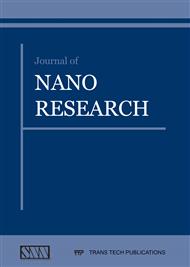[1]
H.K. Ahn, M. Jung, S.J. Sym, D.B. Shin, S.M. Kang, S.Y. Kyung, J.W. Park, S.H. Jeong, E.K. Cho, A phase II trial of Cremorphor EL-free paclitaxel (Genexol-PM) and gemcitabine in patients with advanced non-small cell lung cancer, Cancer Chemoth. Pharm. 74 (2014).
DOI: 10.1007/s00280-014-2498-5
Google Scholar
[2]
Y. Matsumura, T. Hamaguchi, T. Ura, K. Muro, Y. Yamada, Y. Shimada, K. Shirao, T. Okusaka, H. Ueno, M. Ikeda, N. Watanabe, Phase I clinical trial and pharmacokinetic evaluation of NK911, a micelle-encapsulated doxorubicin, Br. J. Cancer 91 (2004).
DOI: 10.1038/sj.bjc.6602204
Google Scholar
[3]
X. Yi, Q. Zhang, D. Zhao, J. Xu, Z. Zhong, R. Zhuo, F. Li, Preparation of pH and redox dual-sensitive core crosslinked micelles for overcoming drug resistance of DOX, Polym. Chem. 7 (2016) 1719-1729.
DOI: 10.1039/c5py01783a
Google Scholar
[4]
S.H. Kim, J.P. Tan, F. Nederberg, K. Fukushima, J. Colson, C. Yang, A. Nelson, Y.Y. Yang, J.L. Hedrick, Hydrogen bonding-enhanced micelle assemblies for drug delivery, Biomaterials 31 (2010) 8063-8071.
DOI: 10.1016/j.biomaterials.2010.07.018
Google Scholar
[5]
E.S. Lee, K.T. Oh, D. Kim, Y.S. Youn, Y.H. Bae, Tumor pH-responsive flower-like micelles of poly(L-lactic acid)-b-poly(ethylene glycol)-b-poly(L-histidine), J. Control. Release 123 (2007) 19-26.
DOI: 10.1016/j.jconrel.2007.08.006
Google Scholar
[6]
J.V.M. Weaver, Y.Q. Tang, S.Y. Liu, P.D. Iddon, R. Grigg, N.C. Billingham, S.P. Armes, R. Hunter, S.P. Rannard, Preparation of shell cross-linked micelles by polyelectrolyte complexation, Angew. Che. Int. Edit. 43 (2004) 1389-1392.
DOI: 10.1002/anie.200352428
Google Scholar
[7]
W. Fan, Y. Wang, X. Dai, L. Shi, D. McKinley, C. Tan, Reduction-responsive crosslinked micellar nanoassemblies for tumor-targeted drug delivery, Pharm. Res. 32 (2015) 1325-1340.
DOI: 10.1007/s11095-014-1537-6
Google Scholar
[8]
Y. Zhong, J. Zhang, R. Cheng, C. Deng, F. Meng, F. Xie, Z. Zhong, Reversibly crosslinked hyaluronic acid nanoparticles for active targeting and intelligent delivery of doxorubicin to drug resistant CD44+ human breast tumor xenografts, J. Control. Release 205 (2015).
DOI: 10.1016/j.jconrel.2015.01.012
Google Scholar
[9]
Y. Shao, W. Huang, C. Shi, S.T. Atkinson, J. Luo, Reversibly crosslinked nanocarriers for on-demand drug delivery in cancer treatment, Ther. deliv. 3 (2012) 1409-1427.
DOI: 10.4155/tde.12.106
Google Scholar
[10]
H.S. Han, K.Y. Choi, H. Ko, J. Jeon, G. Saravanakumar, Y.D. Suh, D.S. Lee, J.H. Park, Bioreducible core-crosslinked hyaluronic acid micelle for targeted cancer therapy, J. Control. Release 200 (2015) 158-166.
DOI: 10.1016/j.jconrel.2014.12.032
Google Scholar
[11]
Q.H. Sun, M. Radosz, Y.Q. Shen, Challenges in design of translational nanocarriers, J. Control. Release 164 (2012) 156-169.
DOI: 10.1016/j.jconrel.2012.05.042
Google Scholar
[12]
S. Guragain, B.P. Bastakoti, V. Malgras, K. Nakashima, Y. Yamauchi, Multi-stimuli-responsive polymeric materials, Chem. Eu. J. 21 (2015) 13164-13174.
DOI: 10.1002/chem.201501101
Google Scholar
[13]
S. Bhatnagar, V.V.K. Venuganti, Cancer targeting: responsive polymers for stimuli-sensitive drug delivery, J. Nanosci. Nanotechno. 15 (2015) 1925-(1945).
DOI: 10.1166/jnn.2015.10325
Google Scholar
[14]
W.W. Gao, J.M. Chan, O.C. Farokhzad, pH-responsive nanoparticles for drug delivery, Mol. Pharmaceut. 7 (2010) 1913-(1920).
DOI: 10.1021/mp100253e
Google Scholar
[15]
S. Jiang, Y. Yao, Y.Z. Nie, J.J. Yang, J. Yang, Investigation of pH-responsive properties of polymeric micelles with a core-forming block having pendant cyclic ketal groups, J. Colloid Interf. Sci. 364 (2011) 264-271.
DOI: 10.1016/j.jcis.2011.08.013
Google Scholar
[16]
M. Kanamala, W.R. Wilson, M. Yang, B.D. Palmer, Z. Wu, Mechanisms and biomaterials in pH-responsive tumour targeted drug delivery: a review, Biomaterials 85 (2016) 152-167.
DOI: 10.1016/j.biomaterials.2016.01.061
Google Scholar
[17]
M. Cao, X. Liu, J. Tang, M. Sui, Y. Shen, Facile synthesis of size-tunable stable nanoparticles via click reaction for cancer drug delivery, Sci. China Chem. 57 (2014) 633-644.
DOI: 10.1007/s11426-014-5074-2
Google Scholar
[18]
D. Willner, P.A. Trail, S.J. Hofstead, H.D. King, S.J. Lasch, G.R. Braslawsky, R.S. Greenfield, T. Kaneko, R.A. Firestone, (6-maleimidocaproyl)hydrazone of doxorubicin-a new derivative for the preparation of immunoconjugates of doxorubicin, Bioconjugete Chem. 4(1993).
DOI: 10.1021/bc00024a015
Google Scholar
[19]
K. Dan, S. Ghosh, One-Pot Synthesis of an acid-labile amphiphilic triblock copolymer and its pH-responsive vesicular assembly, Angew. Che. Int. Edit. 52 (2013) 7300-7305.
DOI: 10.1002/anie.201302722
Google Scholar
[20]
H. Mizutani, S. Tada-Oikawa, Y. Hiraku, M. Kojima, S. Kawanishi, Mechanism of apoptosis induced by doxorubicin through the generation of hydrogen peroxide, Life Sci. 76 (2005) 1439-1453.
DOI: 10.1016/j.lfs.2004.05.040
Google Scholar


